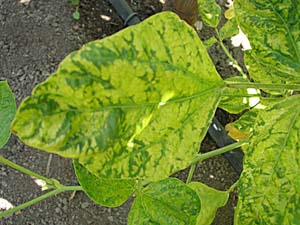PROPAGATION / SOWING OF BUSH BEANS:
Direct seed bush beans after risk of frost when soil warms to 18-24°C (65-75°F). Sow bush beans 1" deep and 2" apart in rows 18" (bush beans) to 24" apart (shell beans). Reseed until mid summer for a constant supply all season long. If using untreated bush beans seed, plant thicker and thin to desired density.
CARE & GROWING OF BUSH BEANS:
Bush bean types require a full sun location, soil pH of 6.5-7.5, and well drained soil. Good air circulation around bush bean plants is essential, especially for late shelling or dry type beans, as they are very susceptible to fungal diseases which prevail later in the season. Bush beans are light feeders; compost or well rotted manures worked into the soil at the time of planting is sufficient.
HARVESTING OF BUSH BEANS:
Use maturity days as an indicator. Harvest once the bush beans are smooth, firm and crisp. Keep bush beans constantly picked to ensure a fresh supply. Bean formation in the pod is a sure sign of over-maturity. Dry & Shell Beans: Harvest when the bush beans pods are completely dry and brittle. Cut or pull pods from bush bean plants and shell the beans. Store beans in an air tight container in a cool dry spot. For fresh eating of horticultural or shell beans, harvest when bean formation starts to take place within the pod.
Common Problems :
 Mosaic Diseases : The bean mosaic diseases cause plants to turn a yellowish green and produce few or no pods. The leaves on infected plants are a mottled yellow and are usually irregularly shaped. The only satisfactory control for these diseases is to use mosaic-resistant bean varieties. Mosaic Diseases : The bean mosaic diseases cause plants to turn a yellowish green and produce few or no pods. The leaves on infected plants are a mottled yellow and are usually irregularly shaped. The only satisfactory control for these diseases is to use mosaic-resistant bean varieties.
 Bacterial Bean Blight : Bright yellow or brown spots on the leaves or water-soaked spots on the pods are signs of bacterial bean blight. Bacterial blight is best controlled by planting disease-free seed; avoiding contact with wet bean plants; and removing all bean debris from. the garden Bacterial Bean Blight : Bright yellow or brown spots on the leaves or water-soaked spots on the pods are signs of bacterial bean blight. Bacterial blight is best controlled by planting disease-free seed; avoiding contact with wet bean plants; and removing all bean debris from. the garden
 Rust of Bean : Most beans are susceptible to Rust. The disease occurs sporadically and is important only under prolonged periods of warm, moist weather. The Rust fungus exists in at least 35 pathotypes and is extremely variable. Symptoms develop on leaves and pods as pustules of red-brown powdery spores (urediniospores) which rupture the epidermis. They are often surrounded by a yellow halo. Severely infected leaves turn chlorotic, dry, and decline. Later, black to brown teliospores form within pustules and enable the pathogen survive between crop cycles. Rust of Bean : Most beans are susceptible to Rust. The disease occurs sporadically and is important only under prolonged periods of warm, moist weather. The Rust fungus exists in at least 35 pathotypes and is extremely variable. Symptoms develop on leaves and pods as pustules of red-brown powdery spores (urediniospores) which rupture the epidermis. They are often surrounded by a yellow halo. Severely infected leaves turn chlorotic, dry, and decline. Later, black to brown teliospores form within pustules and enable the pathogen survive between crop cycles.
 Powdery Mildew : This common bean disease thrive in both humid and dry weather. The spores are spread by the wind to healthy plants. the fungi sap plant nutrients , causing yellowing and sometimes death of the leaf. A severe infection may kill the plant. Powdery mildew can spread rapidly through a closely spaced planting. Powdery Mildew : This common bean disease thrive in both humid and dry weather. The spores are spread by the wind to healthy plants. the fungi sap plant nutrients , causing yellowing and sometimes death of the leaf. A severe infection may kill the plant. Powdery mildew can spread rapidly through a closely spaced planting.
 Bean Leaf Beetle : This insect attacks all beans. Adults feed on the underside of leaves, blossoms, and pods throughout the growing season. The beetles are yellow to red with black spots and a black band around the outer edge of the body. Both adults and grubs cause serious damage to young plant. Bean Leaf Beetle : This insect attacks all beans. Adults feed on the underside of leaves, blossoms, and pods throughout the growing season. The beetles are yellow to red with black spots and a black band around the outer edge of the body. Both adults and grubs cause serious damage to young plant.
|